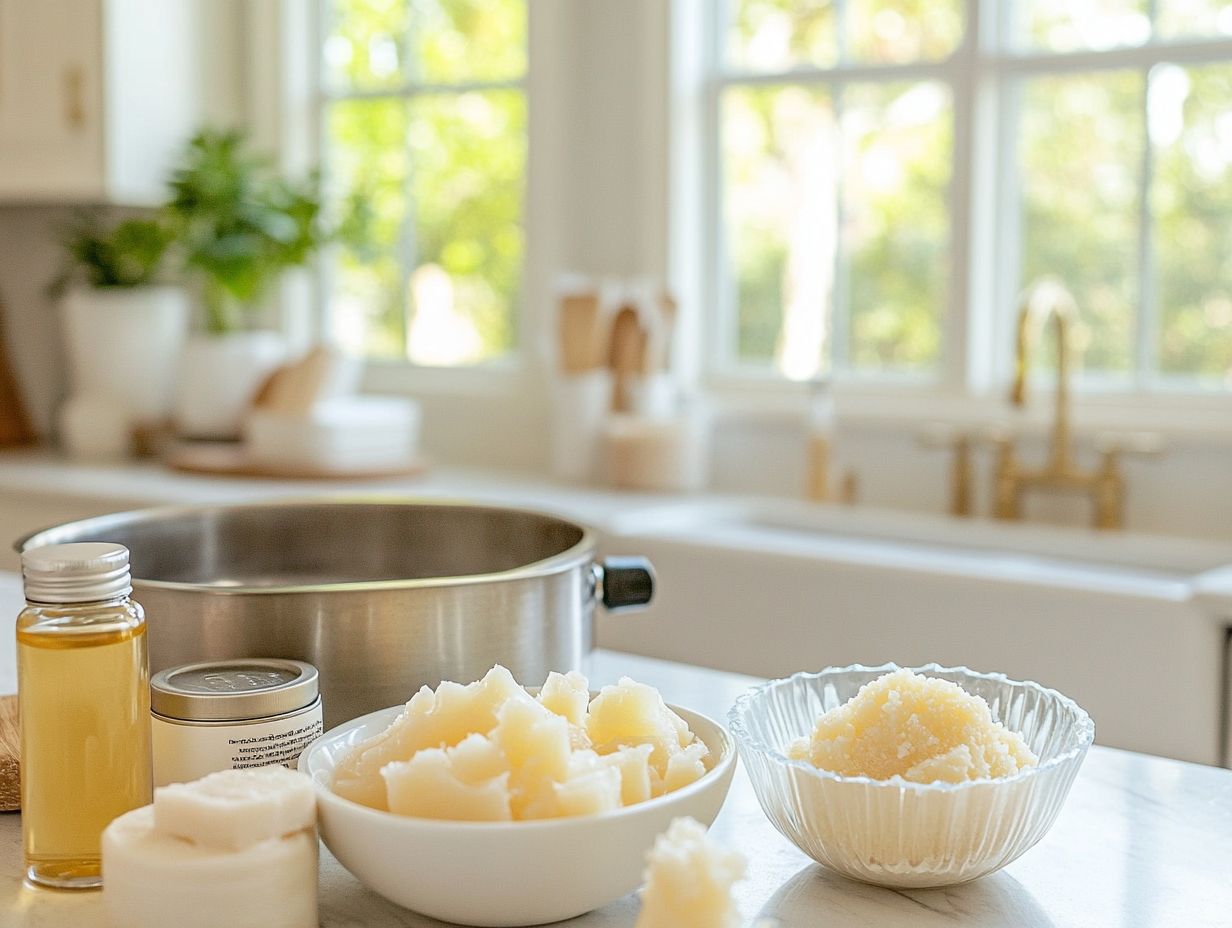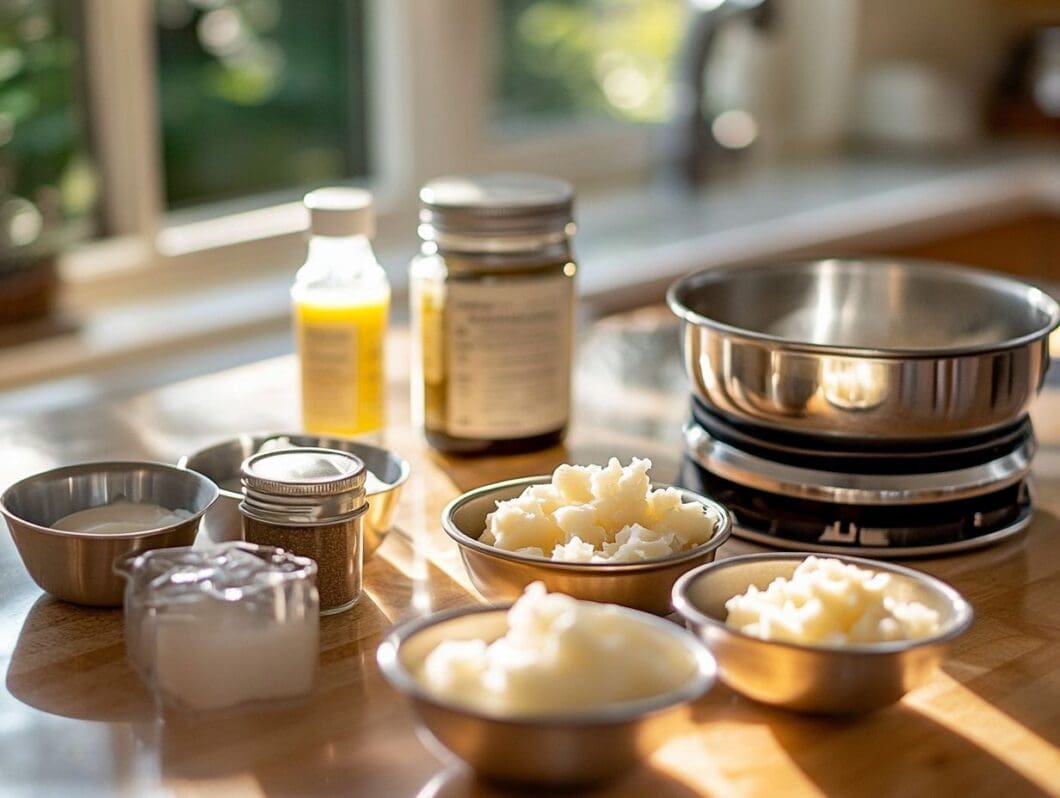In a world filled with commercial beauty products, making your own lip balm offers a delightful blend of creativity and practicality.
You can customize flavors and colors to suit your style, and choose quality ingredients that nourish your lips.
This guide walks you through the essentials you’ll need, from ingredients to tools, and provides a step-by-step process to craft your perfect balm.
Discover tips for storage and innovative uses beyond just moisturizing your lips!
Key Takeaways:

Why Make Your Own Lip Balm?
Creating your own DIY lip balm is not only an enjoyable and fulfilling endeavor but also a means to ensure the use of natural ingredients that are beneficial for the skin. In an era dominated by commercial beauty products often containing synthetic additives, homemade lip balm presents a safer alternative, allowing individuals to customize moisturizing properties to meet their specific needs.
Crafting lip balm can serve as an engaging DIY project, whether undertaken alone or with friends, and it can also function as a thoughtful gift for loved ones who value natural skin care.
The process of making lip balm give the power tos individuals to select nourishing ingredients such as beeswax, coconut oil, and essential oils, ensuring a luxurious texture while promoting hydration. Each formulation can reflect personal preferences, ranging from fruity flavors to calming herbal blends, transforming a simple balm into a unique expression of creativity.
As the DIY beauty trend continues to flourish, this activity fosters a deeper appreciation for natural products and provides a sense of accomplishment. Whether for personal use or as charming, homemade gifts, these bespoke balms serve as a delightful celebration of natural beauty.
Ingredients and Supplies You’ll Need
To successfully formulate a nourishing and effective DIY lip balm, it is imperative to gather the appropriate ingredients and supplies.
The primary components, including coconut oil, beeswax, shea butter, and cocoa butter, create a robust base that not only moisturizes but also protects the lips. Furthermore, the inclusion of essential oils, such as peppermint oil, can provide a refreshing fragrance while imparting therapeutic benefits.
It is equally important to ensure that suitable lip balm containers—whether tubes, palettes, or jars—are on hand for proper storage and application.
Essential Ingredients for Lip Balm

When formulating a high-quality DIY lip balm, it is essential to understand the key ingredients that contribute to optimal moisturizing properties and skin benefits. Coconut oil acts as a natural moisturizer, while beeswax forms a protective barrier that effectively locks in hydration. The inclusion of shea butter and cocoa butter enhances the balm’s texture, resulting in a creamy and nourishing product.
Essential oils not only provide pleasant fragrances but also offer specific benefits; for instance, peppermint oil delivers an invigorating sensation. Additionally, incorporating vitamin E oil increases the shelf life of the homemade lip balm, solidifying its status as a beauty staple.
Beyond these fundamental components, the addition of jojoba oil can significantly improve the moisturizing effect due to its similarity to the skin’s natural oils, thereby promoting healthy hydration without an oily residue. Avocado oil presents another excellent option, as it is rich in fats and vitamins, offering deep nourishment and enhanced elasticity for the lips.
Furthermore, utilizing natural colorants derived from beetroot or fruit extracts not only enhances the aesthetic appeal of the balm but also imparts antioxidant properties. By meticulously selecting these ingredients, one can create a lip balm that is both restorative and luxurious, ensuring soft, supple lips throughout the year.
Tools and Containers
To effectively create and store homemade lip balm, it is essential to utilize the appropriate tools and containers. Selecting lip balm tubes or a lip balm palette facilitates easy application and portability, while glass and plastic containers provide versatile storage solutions.
Additionally, repurposing items such as a jewelry organizer can help in systematically arranging lip balm supplies. Retailers like The Container Store, Amazon, and Sephora offer a diverse selection of functional and aesthetically pleasing storage options for DIY projects.
When choosing containers, it is important to consider the size and material that align with one’s lifestyle; for instance, sturdier containers are preferable for travel, while smaller containers conveniently fit into a purse. Specialty craft stores may also offer unique designs that reflect individual style.
To maintain organization, it is advisable to create a checklist of necessary supplies, ensuring easy access to ingredients and tools when inspiration arises. By thoughtfully selecting both containers and organizational methods, the process of crafting lip balms becomes not only efficient, but also an enjoyable and rewarding endeavor.
Step-by-Step Guide to Making Lip Balm
This practical step-by-step guide provides a method for creating a DIY lip balm utilizing straightforward ingredients such as beeswax, coconut oil, and shea butter, resulting in a moisturizing and pleasant product.
Begin by assembling all necessary supplies and organizing your workspace to facilitate an efficient crafting experience. The procedure entails melting the beeswax and blending it with the oils, enabling customization of the lip balm recipe according to individual preferences.
Once the mixture is thoroughly combined, pour it into selected lip balm containers and allow it to set for a nourishing finish.
Creating the Base

The foundation of an exceptional DIY lip balm is established through the creation of a balanced base utilizing key ingredients such as beeswax, coconut oil, shea butter, and cocoa butter.
To attain the ideal consistency, it is essential to employ the correct proportions; generally, a combination of one part beeswax to three parts oils, including coconut and shea butter, yields a smooth and pliable balm. Each ingredient fulfills a specific function: beeswax not only provides a protective barrier but also possesses emulsifying properties that facilitate the seamless blending of the components.
Coconut oil, renowned for its hydrating attributes, penetrates the skin effectively to retain moisture, while shea butter offers nourishment through its vitamins and antioxidants.
Cocoa butter, on the other hand, enhances the formulation with a luxurious, buttery texture, rendering the balm exceptionally soothing and effective in preventing dryness. Collectively, these ingredients create a harmonious blend of benefits that will undoubtedly be appreciated by the lips.
Adding Flavor and Color
Enhancing DIY lip balm with flavor and color can significantly elevate its appeal and overall user experience. By incorporating a selection of safe and natural ingredients, one can create a personalized product that nourishes the lips while also showcasing individual creativity.
For flavoring, citrus essential oils, such as sweet orange or lemon, can impart a vibrant and zesty character, whereas floral options like lavender or rose may offer a gentle sweetness. In terms of coloration, beetroot powder and spirulina emerge as excellent choices, providing an appealing hue while remaining entirely natural.
With these options available, the process of crafting a beautiful and aromatic lip balm transforms into an enjoyable project that reflects personal individuality.
Customizing for Different Needs
Crafting your own lip balm offers the unique advantage of customization to meet diverse needs and preferences, ensuring optimal moisturizing properties tailored to specific skin types. For instance, incorporating particular essential oils can provide additional benefits, such as soothing inflammation or enhancing hydration, thereby making the DIY project highly personalized.
Whether creating a hydrating balm for dry lips or a scented balm as a thoughtful gift, the possibilities for customization are extensive, particularly with natural ingredients.
By experimenting with butters such as shea or cocoa, one can achieve a rich texture that deeply nourishes the lips, while beeswax can enhance the balm’s longevity and protect delicate skin from environmental stressors. The inclusion of ingredients like honey or aloe vera can offer a soothing effect for chapped lips, accommodating various sensitivities.
As individuals explore unique flavor combinations, they may discover that certain fruits or herbs can invigorate the senses while delivering moisturizing benefits. Ultimately, this personalized approach facilitates the development of a lip care solution that aligns seamlessly with individual skin requirements, resulting in a delightful and effective product.
Tips for Storing and Using Your Homemade Lip Balm

Proper storage and application techniques are essential for maintaining the quality and effectiveness of homemade lip balm over time. Utilizing suitable containers, such as glass or BPA-free plastic, is crucial for preserving freshness and extending shelf life.
Furthermore, understanding the correct method of application ensures that users receive maximum moisturizing benefits while minimizing waste, a particularly significant consideration when employing high-quality natural ingredients.
Proper Storage Techniques
Proper storage of homemade lip balm is essential for ensuring its longevity and effectiveness, making the selection of containers a critical consideration. It is advisable to choose airtight lip balm containers to prevent moisture and air from compromising the quality. Options include glass containers as well as durable plastic containers.
Additionally, storing the balm in a cool, dry location away from direct sunlight will further enhance its shelf life, protecting the natural ingredients from heat and light exposure.
Labeling the containers with the production date is recommended to facilitate tracking of freshness. If multiple batches are being produced, utilizing smaller containers can aid in sharing and gifting while minimizing exposure to external elements each time the main jar is opened.
For those interested in enhancing their balm with essential oils, it is important to store these oils appropriately to maintain their potency. Before use, it is advisable to check for any changes in texture or scent, as these may indicate that the homemade balm is no longer effective or safe.
How to Apply Lip Balm
Applying lip balm correctly is crucial to maximizing its moisturizing properties and ensuring that your lips remain soft and hydrated throughout the day. Begin with clean, dry lips to allow optimal absorption. Using your fingertip or an applicator, gently spread the balm evenly across the surface of your lips. For best results, it is advisable to reapply throughout the day as needed, particularly after eating or drinking, in order to maintain the protective layer of moisture provided by your lip balm.
Additionally, it is important to consider the ingredients in the lip balm you select, as some formulations contain beneficial components such as beeswax or essential oils that can enhance hydration. Another effective technique is to gently exfoliate your lips prior to application; this removes any dry skin and allows the balm to penetrate deeply and effectively. Utilizing a lip scrub once a week can significantly improve the overall texture and appearance of your lips.
Lastly, it is prudent to carry your lip balm in your bag or pocket, making reapplication a seamless part of your daily routine.
Additional Uses for Your Homemade Lip Balm
Plus moisturizing the lips, homemade lip balm offers a range of versatile applications, demonstrating its utility in various beauty projects and practical uses. It can effectively soothe dry cuticles and serve as a natural highlighter for the cheeks, thanks to its moisturizing properties.
By exploring innovative methods to integrate lip balm into daily routines, individuals can not only maximize its value but also enhance their overall beauty regimen.
Creative Ways to Use Lip Balm
There are numerous innovative applications for DIY lip balm, elevating it beyond a mere product for lip care. For example, it can be utilized to manage flyaway hairs, moisturize dry skin patches, or even function as an effective makeup remover. Its moisturizing properties lend themselves well to a variety of beauty projects, ensuring that a practical solution is readily available for unforeseen needs.
This versatile balm can also function as a nourishing cuticle cream, promoting healthy nails and smooth skin. A simple application can enhance the eyes by providing a subtle sheen, making it an excellent choice for achieving a fresh, dewy appearance.
For those who appreciate crafting, incorporating homemade lip balm into lip scrub formulations can enhance hydration while introducing a pleasant fragrance. These inventive approaches not only underscore the practicality of a DIY beauty project but also encourage creativity, enabling individuals to effortlessly customize their beauty essentials.


